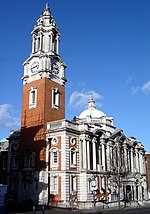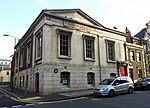Woolwich Arsenal station

Woolwich Arsenal station is a National Rail and Docklands Light Railway (DLR) paired interchange station in the heart of Woolwich in the Royal Borough of Greenwich. It has two parts; its raised, south-western part of the station is on the semi-slow, commuter service, corollary of the North Kent Line and also in its Dartford Loop services section between London and Dartford, run by Southeastern. Regular services beyond Dartford are to the Medway Towns, which start/finish in the opposite direction at Luton via the City of London, West Hampstead and St Albans. Its other part is the terminus of its own branch of the DLR, run by Transport for London. The older part of the station, built in a modernist style, is located on a corner of General Gordon Square, a green town square. The newer part has entrances to Woolwich's subterranean end of the DLR, and faces the top of Powis Street, a long, semi-pedestrianised retail avenue. It is named after the area's Woolwich or Royal Arsenal, to distinguish the Arsenal site from the former Royal Dockyard, which before the 19th century was complemented with wharves and yards for large naval ships. In zoning it is the furthest DLR station – in Travelcard Zone 4. On the national network, it is 9 miles 32 chains (15.1 km) down from London Charing Cross.
Excerpt from the Wikipedia article Woolwich Arsenal station (License: CC BY-SA 3.0, Authors, Images).Woolwich Arsenal station
Woolwich New Road, London
Geographical coordinates (GPS) Address Nearby Places Show on map
Geographical coordinates (GPS)
| Latitude | Longitude |
|---|---|
| N 51.49 ° | E 0.069 ° |
Address
Woolwich Arsenal Station
Woolwich New Road
SE18 6EU London (Royal Borough of Greenwich)
England, United Kingdom
Open on Google Maps








